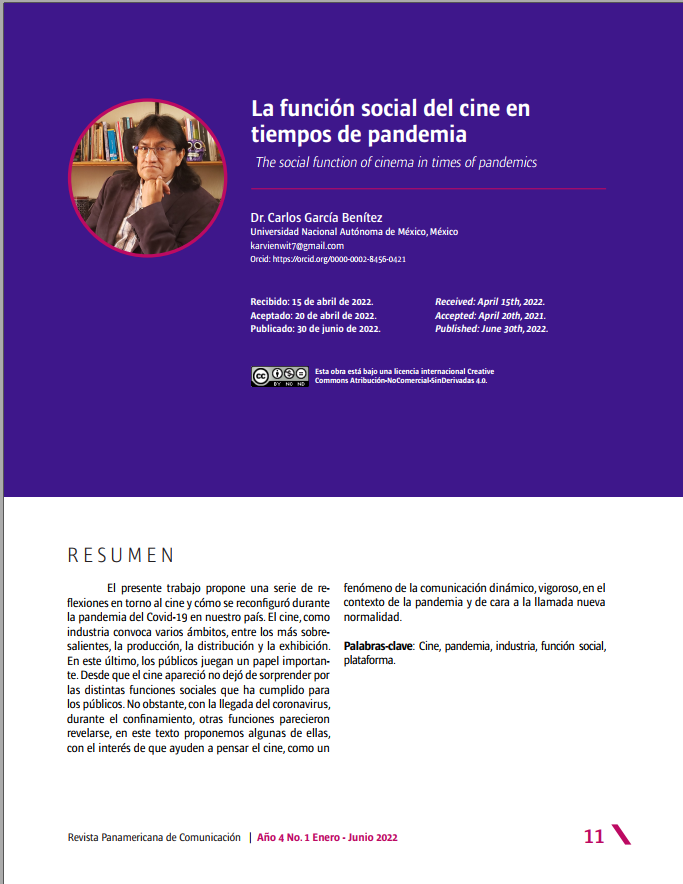La función social del cine en tiempos de pandemia
Contenido principal del artículo
Resumen
El presente trabajo propone una serie de reflexiones en torno al cine y cómo se reconfiguró durante la pandemia del Covid-19 en nuestro país. El cine, como industria convoca varios ámbitos, entre los más sobresalientes, la producción, la distribución y la exhibición. En este último, los públicos juegan un papel importante. Desde que el cine apareció no dejó de sorprender por las distintas funciones sociales que ha cumplido para los públicos. No obstante, con la llegada del coronavirus, durante el confinamiento, otras funciones parecieron revelarse, en este texto proponemos algunas de ellas, con el interés de que ayuden a pensar el cine, como un fenómeno de la comunicación dinámico, vigoroso, en el contexto de la pandemia y de cara a la llamada nueva normalidad.
Detalles del artículo
Sección

Esta obra está bajo una licencia internacional Creative Commons Atribución-NoComercial-SinDerivadas 4.0.
Cómo citar
Referencias
»Alfaro, H & Ochoa A. (1998). La república de los cines. México, Clío.
»Almacellas, M. A. (2004). Educar con el cine (22 películas). Madrid, Ediciones Universitarias Internacionales.
» Ayala Blanco, J. (2021), Cine y Covid. Nuevos acercamientos estéticos y narrativos. Facebook ofcial de la ENAC. Consultado el 3 de marzo de 2022. En línea: https://www.facebook.com/enacunam/videos/486234272601835
» Coria, L. F. (2006). Taller de cineflia. México, Paidós.
» Cousins, M. (2004). Historia del cine. Londres, Blume.
» De los Reyes A. (1984). Los orígenes del cine en México, 1896-1900. México, FCE-SEP.
» De los Reyes, A. (1992). La vida en México en el siglo XX-1. Y cuando el cine llegó a México. Youtube ofcial de la Filmoteca UNAM. Consultado el 30 de marzo de 2022. En línea: https://www.youtube.com/watch?v=P2_vk0H0bWQ
» Ferro, M. (1980). Cine e historia. Barcelona, Gustavo Gilli.
» Freud, S. (1997). El malestar en la cultura. España, Alianza editorial.
» García Riera. E. (1974). El cine y su público. México, FCE.
» Gubern, R. (2014). Historia del cine. Barcelona, Anagrama.
» Hobsbawm, E. (1998). Historia del siglo XX. Buenos Aires, Grijalbo Mondadori.
» Imbert, Gérard. (2010). Cine e imaginarios sociales. El cine posmoderno como experiencia de los límites. (1990-2010). Madrid,
Cátedra.
» Lara, R. (2022). El cine en el entorno digital pospandemia. Facebook ofcial de la FES Aragón, UNAM. Consultado el 6 de abril de 2022. En línea: https://www.facebook.com/FESAragon.comunicacion/videos/552963576089242
» Marketing News. (2021). Las plataformas de ‘streaming’, las grandes benefciadas por los nuevos hábitos creados por la pandemia. Blog ofcial de Marketing News. Consultado el 4 de abril de 2022. En línea: https://www.marketingnews.es/investigacion/noticia/1165647031605/plataformas-de-streaming-grandes-benefciadas-nuevos-habitos-creados-pandemia.1.html
» Metz, CH. (1977). El signifcante imaginario. Psicoanálisis y cine. Barcelona, Paidós.
» Monsiváis, C. (2003). “Función corrida (el cine mexicano y la cultura popular urbana)”, en José Manuel Valenzuela Arce (Coordinador) Los estudios culturales en México. México, FCE.
» Morin, É. (2001). El cine o el hombre imaginario. Barcelona, Paidós.
» Rosenstone, A. R. (1997). El pasado en imágenes. El desafío del cine a nuestra idea de la historia. Barcelona, Ariel.
» Sadoul, G. (1969). Las maravillas del cine. México. FCE.
» Shohat, E. & Stam, R. (2002). Multiculturalismo, cine y medios de comunicación. España, Paidós.
» Sorlin, P. (1977). Sociología del cine. La apertura para la historia de mañana. México, FCE.
» Tena Núñez, R. A., García Ayala, J. A., Heredia Alba, F. (2012). Escenópolis, la urbanización impulsada por las artes escénicas en el siglo XXI. México, Plaza y Valdés.
» Tuñón, J. (1995). "Imagen-imaginación-imaginario: jardín público del cine y secreto de la historia” en Carmen Nava y Alejandro
Carrillo (Compiladores), México en el Imaginario. México, UAM Xochimilco.
» Zavala, L. (2000). Elementos del discurso cinematográfco. México, UAM.

